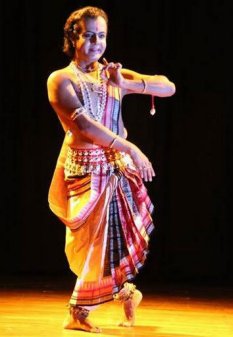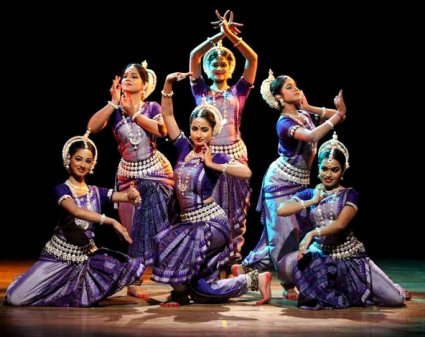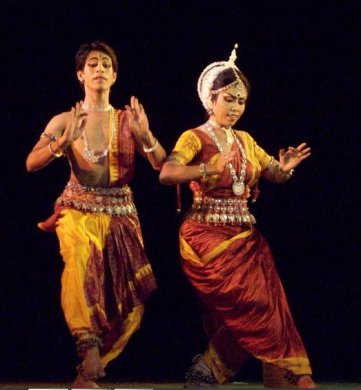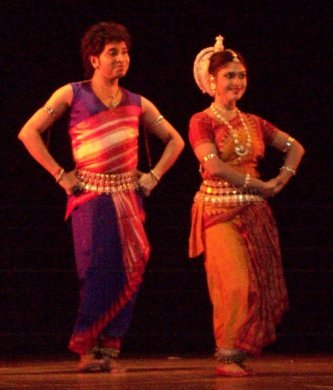
|   |

|   |
Shraddanjali: A two day annual Odissi dance festival - Nita Vidyarthi e-mail: nitavidyarthi@gmail.com August 24, 2015 Srjan Bhubaneswar jointly with Srijan Chhanda, Odissi Dancers’ Forum Kolkata and ICCR under the Horizon Series, organised a two-day Odissi festival Shraddhanjali (14th-15th Aug) in memory of Guru Kelucharan Mohapatra and Sanjukta Panigrahi at the Satyajit Ray Auditorium, ICCR, Kolkata to present a selection of Guruji’s notable compositions of solos, duets as well as group performances along with a few by the other younger teachers. The festival was inaugurated by the Regional Director ICCR Gautam Dey, Minakshi Mishra, The Director of Rabindranath Tagore Centre, Guru Kelucharan’s illustrious son and disciple Guru Ratikant Mohapatra and senior dancer Arundhati Roy, Secretary of the Forum. The Parampara Award instilled by the forum to young dancers was presented to Rajib Bhattacharya’s student Ranjabali Dey.  Rajib Bhattacharya Ranjabali performed a neat Guru Vandana (adi tala, Ragamalika) choreographed by Guru Ratikant set to S. Vighnaraja’s music. Rajib Bhattacharya presented the powerful ‘Ardhanarishwara’ composed by Guruji in 1977 for Sanjukta Panigrahi and performed by dancers in the country, displaying his technical skill and understanding of the subject. However as a senior dancer, more attention to the balance of expressions of the masculine and feminine energies would have made the performance more worthy. While tandava as Shiva (Purush) sparkled, lasya as Parvati (Prakriti) fell short of the divine grace.  Srjan ensemble The Srjan repertory, exhaustively trained to perfection by their highly creative choreographer and Guru Ratikant, ruled the festival with their immaculate performance in the three numbers presented on the first day. Their invocation, the abhang Yehi ho Vitthaley bhaktajana vatsaley Pandurangey by Sant Namdev was replete with devotional fervour, the bhava being cultivated and communicated with Sridhar Phadke’s traditional music and by the competent dancers. This gratifying performance was followed by the spectacular ‘Tarana’ choreographed by Ratikant Mohapatra, set to captivating music by Dr. Vyzarsu Balasubramanium. The amalgam of the classical ‘dhrimdadhrimtana’ and Western contemporary music, heightened the novelty enveloped by the new throbbing effects of percussion. This had an excellent dramatic impact on this stunning fast paced number that dazzled with the fascinating strong yellow and blue diagonal light beams from the top rig designed by Debiprasad Mishra. The choreography did have a few contemporary dance movements but at no point crossed the boundaries of tradition. The traditional costumes too showed good taste which unfortunately some of the groups lacked. It was both a visual and aural pleasure to watch the refreshingly effortless 120 degree slant by the dancers in unison with a momentous freeze in precise geometric form. An older production Kubja, the Hunchback, an episode from Mahabharata choreographed by Guru Ratikant, scripted by Pandit Nityananda Mishra and set to Lakshmikant Palit’s music was performed with equal élan and competence. The piece was embellished with fine choreography, lilting music and the entry with the rolling of the chariot of Krishna and Balaram to Mathura as also the Malayudha drew great applause for its vitality. The aesthetic appeal coupled with showmanship makes Srjan’s performances always memorable. Very creditable indeed! Rina Jana’s ensemble of 2 male and 2 female dancers sustained the interest of the audience with their various formations in the song Ki shobha go kunjey. One missed Rina’s performance though! ‘Madhurashtakam’ by Maya Bhattacharya’s group was a lackluster performance with dancers lacking balance as well as grace. The ragam Shankarabaranam, ektali based Oriya song Mare Bano Dhara by Kakoli Bose and group was ordinary. Chhanda Manjari’s presentation of Kirwani Pallavi in jhula taal had young learners and so did the Kalakshetram dancers trained by Susmita Bhattacharya with a reasonably senior Saswati Sarkar presenting the Durga Stuti Jai Bhagavati Devi in raga Durga, on the second day. The second evening being the Independence Day, Srjan once again mesmerized the audience with the opening invocation number, the magnificent ‘Vande Mataram’ composed by Guru Kelucharan Mohapatra. Among the duets, Subikash Mukherjee, otherwise a fine dancer looked tired in the Yugmadwanda Pallavi with Sayomita Dasgupta. Sayomita negotiated the rhythm and music well with her dancing on this Ratikant Mohapatra composition based on raga Bageshri, chaturashra ektali. Nilanjana Mukherjee and Shibnarayan Banerjee were pleasing in portraying the different imageries of Navadurga in raga Mayamalavagoula, jyoti taal based ‘Bhagavati Stotra’ choreographed by Ratikant. Shibnarayan should resist long strides too often. Krishnendu Roy needs more practice as was evident from his duet with Arpita Venkatesh in Shankarabaranam Pallavi. Usually with a fine stage presence, Debamitra Sengupta did not rise above mediocrity in her execution of the Oriya song Mare bano.  Nilanjana Mukherjee and Shibnarayan Banerjee  Arnab Banerjee and Rajneeta Mehera With the beautiful raga Hamsadhwani, the Pallavi in ektali by Arnab Banerjee and Rajneeta Mehera was impressive. Petite Rajneeta looked lovely and kept her expressions under good control. Arnab’s costume was noteworthy but as a good dancer, he should refrain from the fixed smile on his face. Gunjan Dance Academy’s Dashavatar was a well coordinated enjoyable number. Mrittika Bhattacharya was unable to perform for being indisposed. The absence of Arundhati Roy’s group was also felt. The effort by the Forum for offering a platform as well as encouraging the talents and aspirations of relatively upcoming and junior dancers side by side with the presentations of accomplished dancers like Srjan ensemble is highly appreciable. Discretion in selection of items and teaming of dancers and a bit of grooming in terms of costumes (colour especially) and poise by the senior members of the forum could be an effective activity and exercise of the forum. Dr. Nita Vidyarthi is a critic of performing arts, specialising in dance, dance theatre and expressions and is a regular contributor to The Hindu, and the Statesman Kolkata in dance, vocal music and theatre. She is trained in Kathak, Bharatanatyam and Manipuri as well as vocal, semi-classical music and Rabindra Sangeet. A Science communicator, Ph.D. in Polymer Science, Commonwealth Scholar and a retired Professor of Chemistry, Nita devotes most of her time to dance and theatre writing. |